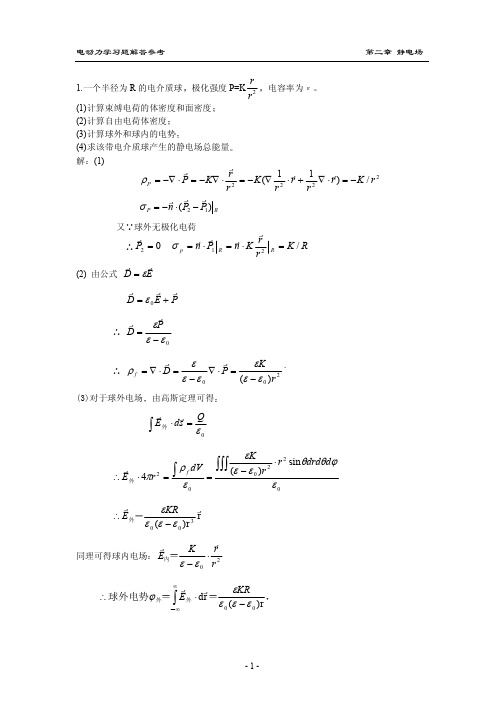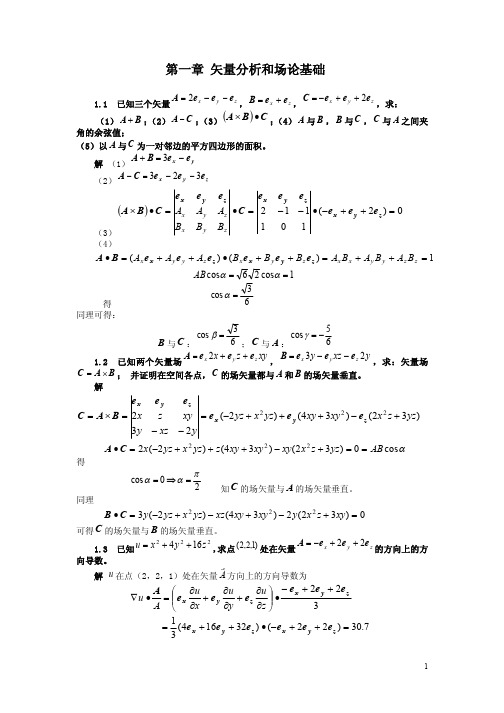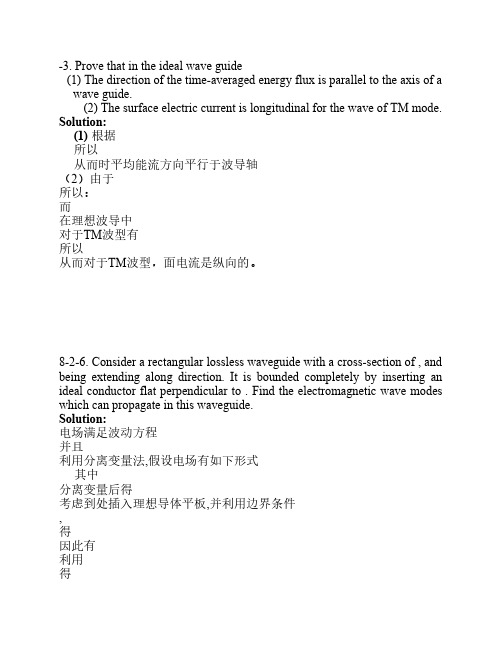刘觉平电动力学课后答案
电动力学课后答案

电动⼒学课后答案第五章多电⼦原⼦1.选择题:(1)关于氦原⼦光谱下列说法错误的是:BA.第⼀激发态不能⾃发的跃迁到基态;B.1s2p 3P2,1,0能级是正常顺序;C.基态与第⼀激发态能量相差很⼤;D.三重态与单态之间没有跃迁(2)氦原⼦由状态1s2p 3P2,1,0向1s2s 3S1跃迁,可产⽣的谱线条数为:BA.0;B.3;C.2;D.1(3)氦原⼦由状态1s3d 3D3,2,1向1s2p3P2,1,0跃迁时可产⽣的谱线条数为:CA.3;B.4;C.6;D.5(4)氦原⼦有单态和三重态两套能级,从⽽它们产⽣的光谱特点是:DA.单能级各线系皆为单线,三重能级各线皆为三线;B.单重能级各线系皆为双线,三重能级各线系皆为三线;C.单重能级各线系皆为单线,三重能级各线系皆为双线;D.单重能级各线系皆为单线,三重能级各线系较为复杂,不⼀定是三线.(5)若某原⼦的两个价电⼦处于2s2p组态,利⽤L-S耦合可得到其原⼦态的个数是:CA.1;B.3;C.4;D.6.(6)设原⼦的两个价电⼦是p电⼦和d电⼦,在L-S耦合下可能的原⼦态有:CA.4个;B.9个;C.12个D.15个;(7)若镁原⼦处于基态,它的电⼦组态应为:CA.2s2s B.2s2p C.3s3s D.3s3p(8)有状态2p3d3P 2s3p3P的跃迁:DA.可产⽣9条谱线B.可产⽣7条谱线C 可产⽣6条谱线D.不能发⽣课后习题1.He 原⼦的两个电⼦处在2p3d态。
问可能组成哪⼏种原⼦态?(按LS耦合)解答:l1 = 1 l2 = 2 L = l1 + l2, l1 + l2?1, ……, | l1? l2| = 3, 2, 1 s1 =1/2 s2 =1/2 S = s1 + s2, s1 + s2?1, ……, |s1 ? s2| = 1, 0 这样按J = L+S, L+S?1, ……, |L?S| 形成如下原⼦态:S = 0 S = 1L = 1 1P13P0,1,2L =2 1D23D1,2,3L = 3 1F33F2,3,43.Zn 原⼦(Z=30) 的最外层电⼦有两个。
电动力学刘觉平版课后答案EDEX第5章 (5)

�
(
�
�
)
�
�
�
�
�
(ϕm 2 )r →∞ = − Hr cos θ
∂ϕ = µ0 m 2 ∂r � � B0 − iωt ( H (t ) = e ) µ0 r =a
(ϕm1 )r =a
∂ϕ = (ϕm 2 ) r = a , µ m1 ∂r
r =a
取金属球外的磁标势 ϕ m 2 的试解为 ϕ m 2 = − Hr cos θ + 球内试解为
第六章
目录:
似稳场
习题 6.5......................................................................................................1
习题 6.5
1 试由导体内场的扩散方程及 Ohm 定律证明: 处于交变场中的导体内的电流密度 j 满足方程
i � � ∇ 2 j − μσ j = 0
�
证明: 导体内的扩散方程 ∇ E − μσ E = 0 , Ohm 定律: j = σ c E 将 Ohm 定律代入扩散方程,得: ∇ 2 j / σ c − µσ j / σ c = 0 即: ∇ 2 j − μσ j = 0
2
�
i �
�
�
(
�
)
(̇ )
� � � x × ( x × B )dv
因为交变磁场中,导体的磁矩由导体内的传导电流产生,
iω 3µσ c � 1 � � m = ∫ x × jdv = − V 2 4 µ + 2 µ0
又
∫
V
� � � � � � � � � � � � − x × ( x × B) = B ( x i x ) − ( Bi x ) x = Br 2 − B r cos θ x
【全】刘觉平电动力学课后习题答案

第一章三維歐氏空間中的張量目录:习题1.1 正交坐标系的转动 (2)习题1.2 物理量在空间转动变换下的分类 (9)习题1.3 物理量在空间反演变换下的进一步分类 (10)习题1.4 张量代数 (15)习题1.5 张量分析 (21)习题1.6 Helmholtz定理 (35)习题1.7 正交曲线坐标系 (38)习题1.8 正交曲线坐标系中的微分运算 (42)习题1.11、 设三个矢量,,a b c r r r 形成右(左)旋系,证明,当循环置换矢量,,a b c r r r的次序,即当考察矢量,,(,,)b c a c a b r rr r r r 时,右(左)旋系仍保持为右(左)旋系。
证明:()V a b c =⨯⋅r r r,对于右旋系有V>0.当循环置换矢量,,a b c r r r次序时, ()V b c a '=⨯⋅r r r =()0c a b V ⨯⋅=〉rr r 。
(*)所以,右旋系仍然保持为右旋系 同理可知左旋系情况也成立。
附:(*)证明。
由于张量方程成立与否与坐标无关,故可以选取直角坐标系,则结论是明显的。
2、 写出矢量诸分量在下列情况下的变换矩阵:当Cartesian 坐标系绕z 轴转动角度α时。
解:变换矩阵元表达式为 ij i j a e e '=⋅r r1112212213233233cos ,sin ,sin ,cos ,0,1a a a a a a a a αααα===-===== 故()cos sin 0sin cos 0001R ααααα⎛⎫⎪=- ⎪ ⎪⎝⎭3、 设坐标系绕z 轴转α角,再绕新的y 轴(即原来的y 轴在第一次转动后所处的位置)转β角,最后绕新的z 轴(即原来的z 轴经第一、二次转动后所处的位置)转γ角;这三个角称为Euler 角。
试用三个转动矩阵相乘的办法求矢量诸分量的在坐标轴转动时的变换矩阵。
解:我们将每次变换的坐标分别写成列向量,,,X X X X '''''', 则 ()()(),,z y z X R X X R X X R X αβγ'''''''''''''===∴()()()z y z X R R R X γβα''''''=绕y '-轴转β角相当于“先将坐标系的y '-轴转回至原来位置,再绕原来的y-轴(固定轴)转β角,最后将y-轴转至y '-轴的位置”。
刘觉平电动力学第3章答案

第三章电磁相互作用的基本规律目录:习题3.1 带电粒子在电磁场中的运动规律 (2)习题3.2 电磁场在外场作用下的运动规律 (2)习题3.3 电磁场的能动张量定理 (20)习题3.4 电磁场的角动量张量定理 (24)习题3.5 介质中的Maxwell方程组 (25)习题3.6 介质中电磁场能-动量与角动量定理 (39)习题3.8 波动方程 (50)习题3.9 平面电磁波的偏振 (55)习题3.10 电磁场的螺旋度 (58)规范不变性的内容都空了,没有处理。
最后两节也没有处理,不过本身做的很详细。
其他都好好看了。
习题3.11. 试证作用量 int 0bp p free a S S S m cds eA dx μμ⎡⎤=+=-⎣⎦⎰在()1U 规范变换 ()111A UA U iU U eμμμ--'=+∂ 下不变。
式中()exp U ie χ∈证明:2. 将带电粒子的加速度用它的速度以及电场强度和磁感强度表示出来解:加速度定义:dva dt =由于()03/20002122d m v dp dv d v dv m m v ma m v dt dt dt dt cdt γγγγ--⎛⎫⎛⎫==+=+-⋅ ⎪ ⎪⎝⎭⎝⎭所以5/25/222dp vv vv ma ma ma I a M dt c c γγ--⎛⎫⎛⎫=+⋅=⋅+=⋅ ⎪ ⎪⎝⎭⎝⎭ 而dpe E v B dt⎡⎤=-+⨯⎣⎦ 所以1a e E v B M -⎡⎤=-+⨯⋅⎣⎦ 其中5/22vv M m I c γ-⎛⎫=+ ⎪⎝⎭ ,是一个二阶张量 习题3.21. 证明由式(3.2.2)定义的电荷密度与式(3.2.3)定义的三维电流密度满足连续性方程。
证明:由式(3.2.2)知电荷密度为3()()()()l l lx Q x x ρδ=-∑由式(3.2.3)知三维电流密度为()33()()()()()()()l l l l l l ldx dx dx j x Q x x Q x x dt dt dt ρδδ==-=-∑∑有33()()()()()()3()()()()()()l l l l l l l l l l l lx x x x dx Q Q t t x dt x x dx Q x dt δδρδ∂-∂-∂==⋅∂∂∂∂-=⋅-∂∑∑∑而()3()()(())l l l ldx j Q x x dt δ∇⋅=∇⋅-∑由于()l dx dt 与x 无关,故3()()()()l l l ldx x x j Q dt x δ∂-∇⋅=⋅∂∑所以0j tρ∂+∇⋅=∂2. 试证:直至A μ的一阶导数,除开一个常数因子,电磁场场强张量的对偶张量是在(1)U 规范变换下不变的唯一的一个二阶赝张量。
电动力学答案chapter2

-5-
电动力学习题解答参考
第二章 静电场
4
均匀介质球 容率为 ε 2
电容率为 ε 1
的中心置一自由电偶极子 Pf
r
球外充满了另一种介质
电
求空间各点的电势和极化电荷分布
提示
同上题
φ=
r r Pf ⋅ R 4πε 1 R 3
+ φ ' ,而 φ ' 满足拉普拉斯方程
解
ε1
∂φ内 ∂R
= ε2
∂φ 外 ∂R 2 Pf cosθ l 1 + ∑ lAl R0 Pl 3 4πε 1 R0 2 Pf cosθ B − ∑ (l 1 l l 2 Pl 3 4πε 1 R0 R0
Qf
4πεR
与球面上的极化电荷所产生的电势的
叠加 后者满足拉普拉斯方程 解 一. 高斯法 在球外 而言
R > R0 ,由高斯定理有
r r ε 0 ∫ E ⋅ ds = Q总 Q f + Q P = Q f
对于整个导体球
束缚电荷 Q P = 0)
r ∴E =
Qf 4πε 0R 2 Qf 4πε 0 R + C.(C是积分常数
导体球是静电平衡
是一个常数
ϕ外
R = R0
= ϕ 0 − E 0 R0 cosθ
b 0 b1 + cosθ = C R0 R02
∴ − E 0 R0 cosθ +
b1 3 cosθ = 0即 b1 = E 0 R0 2 R0
-3-
电动力学习题解答参考
第二章 静电场
ϕ外 ϕ0
又由边界条件 −
3 b0 E 0 R0 E 0 Rcosθ + + cosθ R R2
电动力学答案

r 1 1 a 3(a r )r ( a r ) 3 3 (a r ) 3 3 r r r r r5 (2) (3) [(a r ) r ] r ( a r ) (a r ) r 4a r ( a )
(4) [(a r ) r ] (a r ) r (a r ) r a r
A B 3e x e y 解 (1) A C 3e x 2e y 3e z (2)
ex
ey Ay By
ez Bz
ex 1
ey 0
ez 1
A B C
(3) (4)
Ax Bx
Az C 2
1 1 ( e x e y 2e z ) 0
(uv )
1 u 1 v 1 u 1 v 1 u 1 v ve 1 ue 1 ve 2 ue 2 ve 3 ue 3 h1 q1 h1 q1 h2 q 2 h2 q 2 h3 q3 h3 q3
(2)
1 v 1 u 1 v 1 v 1 u 1 u u e e e v e e e 1 2 3 1 2 3 h q h q h q h q h q h q 2 2 3 3 2 2 3 3 1 1 1 1 uv vu (h3 A3 ) (h2 u ) (h2 A2 ) 1 (h3u ) (uA) A3 u A2 u e 1 h2 h3 q 2 q 2 q 3 q3 (h3u ) (h3 A3 ) (h1 A1 ) 1 (h1u ) A1 u A3 u e 2 h1h3 q3 q3 q1 q1 (h2 A2 ) (h1u ) (h1 A1 ) 1 (h2 u ) A2 u A1 u e 3 h1h2 q1 q1 q 2 q 2
武汉大学刘觉平电动力学第八次作业

3-5-7. On both sides of the interface S there are two isotropic, homogeneous linear media, and on the interface S there is a stationary electric current j . Prove that the electric surface charge density at the interface S is221112(//)ωεσεσ=-⋅n jwher 12n is the normal of the interface (oriented to the medium 2), and i ε and i σ are theelectric constants and conductivity of the i-th medium.Solution :According to the boundary relation1221()D D ω⋅-=n111111j D E εεσ== 222222j D E εεσ== So 221112(//)ωεσεσ=-⋅n j4-9-1.(1) Prove that the interaction energy of an electric dipole moment p with the external constant electric field strength E isW =-⋅p Eand derive from the above formula the force of the external electric field E acting on the electric dipole moment p is()=⋅∇F p E(2) Prove that the force subjecting on the dielectric per unit volume in an external constant electric field strength E is20()2E εε-=∇F Proof :(1) The interaction energy of the charges under consideration and the external const electric field331()()()2e e e U d x d x ρϕρϕρϕ=+=⎰⎰x x For the external const field 00()()e e e e ϕϕϕϕ=⋅∇+-⋅+x +x =E x33000()()()e e e U d x Q d x Q ρϕϕρϕ=-⋅+=-⋅+=-⋅+⎰⎰x E x x x E P EThe second term of the last expression refers to the the interaction energy of an electric dipole moment p with the external constant electric field strength ESo W =-⋅p EIn order to express the electric force, we assume the dipole is subject to a virtual displacement δx . From the virtual work principle()p U δδδ⋅=-=∇⋅⋅F x P E xSo ()()()()=∇⋅=∇⋅∇⋅∇⋅F P E P E +E P =E PSince ()()()∇⋅-⋅∇⨯∇⨯=E P P E =P E 0Thus ()()=∇⋅=⋅∇F E P P E(2)The force exerted on the dielectric()()()200()()22E εεεεεε--=∇⋅∇⋅-=∇⋅=∇F E P =E E E E4-9-9. Inner a cylindrical conducting thin shell of an infinite length and the radius b , there is a coaxial conducting wire with the magnetic permeability 1μ and the radius a , and a mediumwith the magnetic permeability 2μ is filling in between the shell and conducting wire. Find theself-inductance of this kind transmission line per unit length.Hint: Assuming a current I is flowing forwards homogeneously through the conducting wire, and a current I is flowing backwards homogeneously through the shell.Solution :Using the integral form of the last term of Maxwell equationsd d ⋅=⋅⎰⎰⎰H l j σDue to the cylindrical symmetry, we know H is along the tangential direction So 222222Ir Ir ra a H I rπππ⎧=⎪⎪=⎨⎪⎪⎩ ()()r a a r b <≤< And 12222Ir a B I rμπμπ⎧⎪⎪=⎨⎪⎪⎩ ()()r a a r b <≤< For the vertical direction of length l , the total energy is()()22222121222021122ln 2216422ab a I r I I l I l b E rldr rldr a r a μμμμππππππ=⋅⋅+⋅⋅=+⎰⎰ So the self-inductance per length is122214ln 8E b L I l a μμπ⎛⎫==+ ⎪⎝⎭6-5-6. In a superconductor where there is no resistivity the equation of motion of a conduction electron with a mass of m and an electric charge of e - is m e =-x E . Assuming that the number of conduction electrons per unit volume is N .(1) Prove that the electric current s j satisfies the first London equation2s Ne m=j E instead of the Ohm law.(2) Considering the superconductor as a linear, isotropic and homogeneous medium to which Maxwell equations apply, deduce the second London equation2s Ne m∇⨯=-j B (3) For a semi-infinite superconductor to which incorporating the experimental fact that fields cannot be frozen in, show that it can be penetrated by an applied magnetic field to depth of the order of L λ only,where L λ(μ is the magnetic permeability) is the so-calledLondon penetration. Hint: Under the quasi-static approximation, derive equation 22L λ∇=H H ,and then solve it.Solution :(1) Using s Ne Ne =-=-j v rSo 2s Ne Ne m=-=j r E (2) Using t∂∇⨯=-∂B E , we get 22s s m m Ne t Ne t ∂∂⎛⎫∇⨯=∇⨯=∇⨯=- ⎪∂∂⎝⎭B E j j So choosing appropriate initial condition, we get2s Ne m ∇⨯=-j B (3) Using s t∂∇⨯=∂D H +j , we get ()()s s s t tε∂∂∇⨯∇⨯=∇⨯∇⨯=∇⨯∇⨯=∇⨯∂∂D H +j E +j j And ()()()22222s Ne Ne m mμμ∇⨯∇⨯=∇∇⋅-∇∇∇⋅-∇=-∇∇⨯=--H H H =B H H=j B =H So 22Ne m μ∇H =HWe assume that 0()()exp()()exp()x i t z i t ωω=-=-H r H r H So 222()()x x d Ne H z H z dz mμ= Due to energy conservation law, ()0x H z → when z →∞ So 2()(0)exp x x Ne H z H mz μ⎛⎫=- ⎪⎝⎭Let L λ so it can be penetrated by an applied magnetic field to depth of the order of L λ only.。
武汉大学刘觉平电动力学第九次作业

8-1-3. Prove that in the ideal wave guide(1) The direction of the time-averaged energy flux is parallel to the axis of awave guide.(2) The surface electric current is longitudinal for the wave of TM mode.Solution:(1) 根据所以从而时平均能流方向平行于波导轴(2)由于所以:而在理想波导中对于TM波型有所以从而对于TM波型,面电流是纵向的。
8-2-6. Consider a rectangular lossless waveguide with a cross-section of , and being extending along direction. It is bounded completely by inserting an ideal conductor flat perpendicular to . Find the electromagnetic wave modes which can propagate in this waveguide.Solution:电场满足波动方程并且利用分离变量法,假设电场有如下形式其中分离变量后得考虑到处插入理想导体平板,并利用边界条件,得因此有利用得8-6-2. Prove that inner a cylinder resonance cavity with a cross-section of radius and length of , the intrinsic Q-factor of this cavity iswhere is the skin depth of the conductor constituting the cavity.Solution:由品质因素的定义得最后一个等式是因为对于型波来说所以所以所以9-1-1. Show that the retarded potentials satisfy the D’Alembert equation. Solution:对于标量势:所以同理对于矢势:从而有满足D’Alembert方程。
